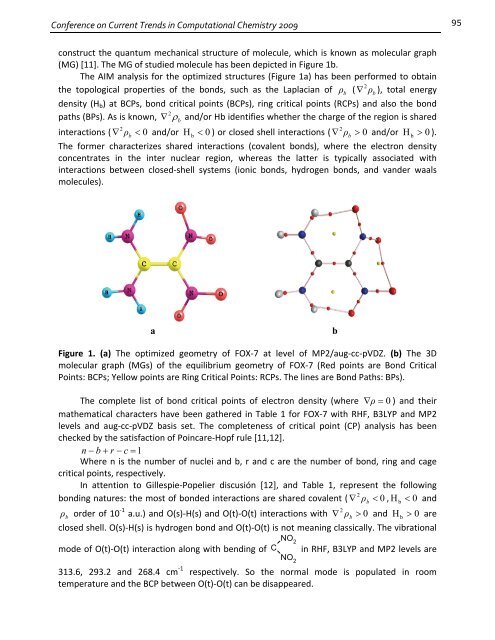Proceedings - Interdisciplinary Center for Nanotoxicity
Proceedings - Interdisciplinary Center for Nanotoxicity
Proceedings - Interdisciplinary Center for Nanotoxicity
You also want an ePaper? Increase the reach of your titles
YUMPU automatically turns print PDFs into web optimized ePapers that Google loves.
Conference on Current Trends in Computational Chemistry 2009<br />
construct the quantum mechanical structure of molecule, which is known as molecular graph<br />
(MG) [11]. The MG of studied molecule has been depicted in Figure 1b.<br />
The AIM analysis <strong>for</strong> the optimized structures (Figure 1a) has been per<strong>for</strong>med to obtain<br />
the topological properties of the bonds, such as the Laplacian of b ρ ( 2<br />
∇ ρb<br />
), total energy<br />
density (Hb) at BCPs, bond critical points (BCPs), ring critical points (RCPs) and also the bond<br />
2<br />
paths (BPs). As is known, ∇ ρb<br />
and/or Hb identifies whether the charge of the region is shared<br />
2<br />
2<br />
interactions ( ∇ ρ b < 0 and/or H b < 0 ) or closed shell interactions ( ∇ ρ b > 0 and/or H b > 0 ).<br />
The <strong>for</strong>mer characterizes shared interactions (covalent bonds), where the electron density<br />
concentrates in the inter nuclear region, whereas the latter is typically associated with<br />
interactions between closed‐shell systems (ionic bonds, hydrogen bonds, and vander waals<br />
molecules).<br />
a b<br />
Figure 1. (a) The optimized geometry of FOX‐7 at level of MP2/aug‐cc‐pVDZ. (b) The 3D<br />
molecular graph (MGs) of the equilibrium geometry of FOX‐7 (Red points are Bond Critical<br />
Points: BCPs; Yellow points are Ring Critical Points: RCPs. The lines are Bond Paths: BPs).<br />
The complete list of bond critical points of electron density (where ∇ρ = 0 ) and their<br />
mathematical characters have been gathered in Table 1 <strong>for</strong> FOX‐7 with RHF, B3LYP and MP2<br />
levels and aug‐cc‐pVDZ basis set. The completeness of critical point (CP) analysis has been<br />
checked by the satisfaction of Poincare‐Hopf rule [11,12].<br />
n − b + r − c = 1<br />
Where n is the number of nuclei and b, r and c are the number of bond, ring and cage<br />
critical points, respectively.<br />
In attention to Gillespie‐Popelier discusión [12], and Table 1, represent the following<br />
2<br />
bonding natures: the most of bonded interactions are shared covalent ( ∇ ρ b < 0 , H b < 0 and<br />
ρ b order of 10 ‐1 2<br />
a.u.) and O(s)‐H(s) and O(t)‐O(t) interactions with ∇ ρ b > 0 and H b > 0 are<br />
closed shell. O(s)‐H(s) is hydrogen bond and O(t)‐O(t) is not meaning classically. The vibrational<br />
mode of O(t)‐O(t) interaction along with bending of C<br />
NO 2<br />
NO 2<br />
in RHF, B3LYP and MP2 levels are<br />
313.6, 293.2 and 268.4 cm ‐1 respectively. So the normal mode is populated in room<br />
temperature and the BCP between O(t)‐O(t) can be disappeared.<br />
95



